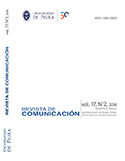
Vol. 17 (2)
2018
Authors:
Pretel Jiménez, M., De Frutos Torres, B. y Sánchez Valle, M.
Artícle
The relationship between brand and consumer in social media: study of the affective link of young people with two technological brands
Received: 15-05-2018 – Accepted: 10-07-2018
References
Ambler, T., & Burne, T. (1999). The impact of affect on memory of advertising. Journal of Advertising Research, 39, 25-34.
Ambler, T. (2000). Persuasion, pride and prejudice: how ads work. International Journal of Advertising, 19(3), 299-315.
Arnold, D. (1992). Cómo gestionar una marca. Barcelona: Parramón.
Barry, T. E., & Howard, D. J. (1990). A review and critique of the hierarchy of effects in advertising. International Journal of Advertising, 9(2), 121-135
Benavides Delgado, J. (2014). Un nuevo enfoque para la comprensión de la marca y la comunicación de las empresas. En Sala, I. & Mira, E. (2014) (coord.). Propectiva y tendencias para la comunicación del siglo XXI. CEU Ediciones: Madrid, pp. 515-535.
Churchill, G. A., JR. (1979). Marketing research: Methodological foundations. Hinsdale, IL: The Dryden Press
Gutiérrez, A. M. (2002). De lo que es capaz de conseguir la publicidad con las marcas. Investigación y Marketing, 75, pp.21-27.
IAB (2017). Estudio anual de redes sociales 2017. Disponible en https://www.slideshare.net/elogia/iab-estudio-anual-redes-sociales-2017
Krugman, H. E. (1965). The impact of television advertising: Learning without involvement. Public opinion quarterly, 29(3), 349-356.
Lavidge, R. J. & Steiner, G. A. (2000). A model for predictive measurements of advertising effectiveness. Advertising & Society Review, 1(1).
López Vázquez, B. (2007). Publicidad emocional. Estrategias creativas. Madrid: ESIC.
Martín Requero, M. I. & Cruz Alvarado López, M. C. (2007). Nuevas tendencias en la publicidad del siglo XXI. Sevilla: Comunicación Social.
Petty, R. E. & Cacioppo, J.T. (1986). The elaboration likelihood model of persuasion. New York: Academic Press.
Roberts, K. (2005). Lovemarks: The Future Beyond Brands. New York: Power House Books.
Strong, E. K. (1925). The Psychology of Selling. Nueva York: MacGraw Hill.
The Cocktail Analysis (2012). Observatorio de redes sociales, 4ª oleada, 2012. Disponible en: http//www.slideshare.net/TCAnalysis/4-oleada-observatorio-de-redes-sociales/download.
The Cocktail Analysis (2016). Observatorio de redes sociales, 8ª oleada, 2016. Disponible en: http://tcanalysis.com/blog/posts/viii-observatorio-de-redes-sociales.
Thomson, M., MacInnis, D. J. & Whan Park, C. (2005). The ties that bind: Measuring the strength of consumers’ emotional attachments to brands. Journal of consumer psychology, 15(1), 77-91.
TNS (2012): Digital life 2012. Disponible en http://www.tnsglobal.com/sites/tnsglobal.es/files/index_jul_13_web.html.
Vakratsas, D., & Ambler, T. (1999). How advertising works: what do we really know?. The Journal of Marketing, 26-43.
Vilaseca, B. (17/9/2006). En la mente del consumidor, El País. Recuperado de http://elpais.com/diario/2006/09/17/negocio/1158500854_850215.html.
Zeitlin, D. M. & Westwood, R. A. (1986). Measuring Emotional Reponse. Journal of Advertising Research, pp. 34-44.
